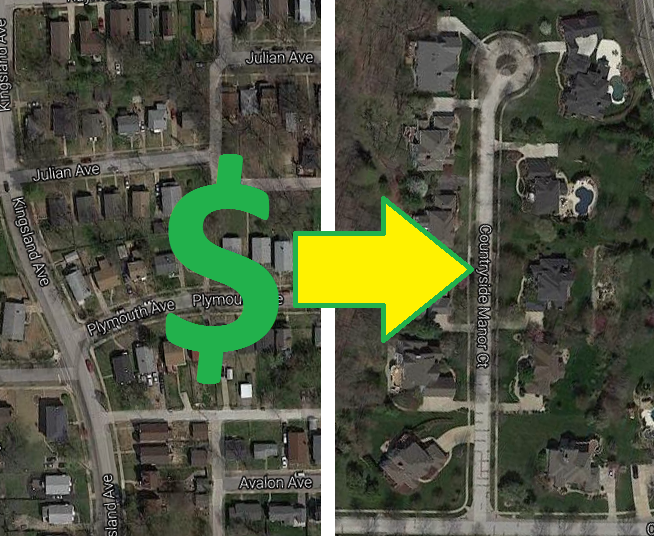
Take a look at your utility bills. Is there any charge related to the amount of infrastructure it takes to serve you? Does it take many or relatively fewer feet of wire to deliver electricity to you? Water pipe? Sewer pipe? Does it take a pumping station to get your sewage out of a valley? There is no frontage charge on our bills. So for the same amount of usage, households closer together subsidize households further apart. Let’s take a look at Missouri American Water, the company that supplies water to St. Louis County, with the exception of Kirkwood.
Missouri American Water has 4,200 miles of water mains and 31,000 fire hydrants in St. Louis County. Bills are calculated with the sum of a minimum customer charge based on water meter diameter and usage (MO American Water rates).
 {From Our Aging Water Infrastructure report by the Metro Water Infrastructure Partnership}
{From Our Aging Water Infrastructure report by the Metro Water Infrastructure Partnership}
Our water infrastructure is aging. With so much needed to serve the spread-out places built after WWII now reaching end-of-life, the development choices of the past are coming home to roost today. Instead of paying into an infrastructure fund from day one to pay for its inevitable replacement, previous generations kicked the can to today.
Recognizing the need to replace old pipes, the Missouri Legislature authorized Missouri American Water to charge customers for infrastructure replacement in 2003. Missouri American Water added a fee on bills called the Infrastructure System Replacement Surcharge (ISRS). Since its inception, MO American Water has spent $445 million on improvements to water distribution and hydrant upgrades in St. Louis County. The rate is $0.7642 per 1000 gallons of water. Again no attempt to charge based on the amount of infrastructure needed to serve a costumer even in the fee that’s paying to replace the infrastructure.
ISRS is currently suspended due to the drop in St. Louis County population in the 2010 census (Drop in St. Louis County population throws wrench at water company).
According to the Our Aging Water Infrastructure report by the Metro Water Infrastructure Partnership, “About 70% of this is for indoor purposes such as showers, toilets, faucets, clothes washers, cooking, and food preparation while the remaining 30% is used outdoors.” We shouldn’t expect usage to be dominated by lot size. Household size is a bigger factor. So an infrastructure fee based on usage is a poor proxy for its cost. The same report says it costs $1M per mile to replace water mains. Let’s do the math and see who the winners and losers are in the ISRS rate structure.
$1M per mile / 5280 feet per mile = $189 / ft
Take half since there are usually homes on both sides of the street, $95/ft
Assume the pipes last 100 years. MO American Water says the typical customer is charged $3.09 per month for ISRS.
$3.09/month * 12 months per year * 100 years = $3708
$3708/$95/ft = 39 ft.
The typical user is paying for 39 feet of watermain. This means the rate is too low and, for average use, the maker versus taker point is near the low end of house frontage in St. Louis County. Add on top the homes that don’t have a neighbor across the street, pipes with no customers on either side, and that a 100-year lifetime is on the high end, it’s likely the rate is much too low.
Some frontage examples from around the county which pretty well traces the ever spreading out as our places became more and more auto-oriented:
140 foot spacing in Chesterfield on Country Side Manor Ct.
100 foot spacing in Ballwin on Bentshire Ct
89 foot spacing in Ellisville on La Dina PL
60 foot spacing in Crestwood on Greenview Dr
50 foot spacing in Rock Hill on Blossom Ln
40 foot spacing in Richmond Heights on Goff Ave
30 foot spacing in University City on Plymouth Ave
What might an ISRS rate based on frontage and that doesn’t kick the can to future generations be?
$95 per ft/100 years/12 months = 7.9 cents /mo /ft that is indexed with inflation of water main replacement costs. The household in Chesterfield would be paying $11.06 per month, and the household on Plymouth would be paying $2.37 per month.
Adding insult to injury, the makers have little say in the decisions to create more takers. When a city in our too-fragmented region zones for sparse land uses they are forcing others in other municipalities with no say in the decision to subsidize this choice. Once again we see how what happens on the other side of our municipal borders does indeed effect us.
